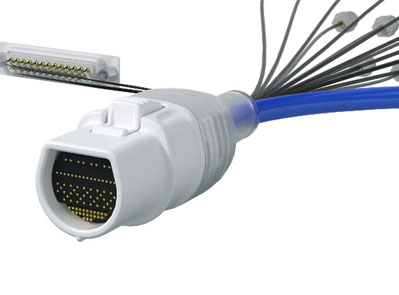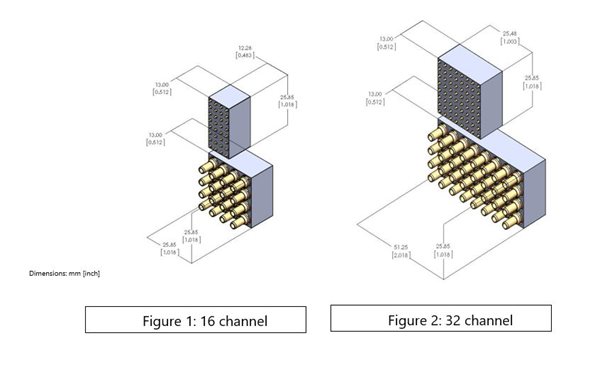MRI (Magnetic Resonance Imaging) systems are used to obtain a clear view of structures inside the body, non-invasively through applying the principal of nuclear magnetic resonance within a powerful magnetic field to image those structures, without the use of potentially harmful X-rays. An RF coil is used as an antenna, around the specific body part to be imaged. It communicates with the RF gradient within the magnetic field. That coil is typically connected into the MRI system with a high frequency cable and connectors.
Since components comprised of magnetic materials hold the potential to interfere with the image, these coil cables and connectors must be non-magnetic. Additionally, the signal, power, and RF contacts used in these connectors must be highly reliable for tens of thousands of mating cycles. However coaxial RF contacts can be large, costly, and fragile. As such, there is pressing need for smaller, more robust, and more cost efficient interconnect systems. Coils are often in direct contact with the patient, so patient comfort is a priority design concern. Wherever it is possible, these coils are made of lightweight materials so that excessive pressure is not applied to the patient being imaged. The size and weight of the cable and connector is also a consideration for the same reason.
Each RF channel in an MRI coil normally requires one coaxial connection and by replacing coaxial contacts with a contact grid array can reduce the size, weight, and cost of the connector. However, by replacing pin and socket contacts with spring probes, cleaning the cable connector can be faster and easier since flat target contacts are simpler to clean than coaxial sockets, thus improving throughput in an MRI suite. There may also be the desire to incorporate a connector at the coil end of the cable to facilitate replacing the cable if it becomes damaged, without need of sending the entire coil out for repair. This dictates the use of a very small connector since it is in even closer proximity to the patient, and connectors that feature an array of contacts make this possible.
Spring Probe PGA Technology
Spring probes have a very high density and mating cycle life, often higher than traditional pin & socket contact systems, and this is needed to keep very expensive MRI systems operating to their full capacity and patient throughput to a maximum. Smiths Interconnect, the leader in spring probe technology, has developed non-magnetic spring probes with mating cycles exceeding 60,000, specifically for MRI applications. Using a spring probe grid array allows for the designer to customize the number of ground pins used to optimize the performance of the connector for specific frequencies/coil designs, saving size, weight, and cost while maintaining the performance of a coax channel where needed. Spring probe grid arrays also simplify cable termination activities by allowing mass solder termination to printed circuit boards.

Comparing the relative size of the PGA and coaxial contact connectors in select applications, the PGA contacts occupy only about ½ the space of traditional coaxial contacts as shown in the examples below for 16 and 32 channel connector pin fields (see Figures 1 & 2)
A typical 16 channel PGA layout, shown in Figure 3 below, incorporates 32 probe contacts, in which 16 are signal and 16 are returns. Each RF channel utilizes 1 signal contact and an adjacent contact for the return:
The analysis of testing commissioned by Smiths Interconnect on pin grid array spring probe connectors, shows that this technology is a very viable next step in MRI coil interconnections. Download the testing report here.
Conclusion
The testing exercise clearly shows that spring probe grid array connectors provide the mechanical, electrical, and optimizable performance required for a typical MRI coil interconnect system, as well as internal connections within the system. This technology provides a non-magnetic interface, reliable mating up to 60,000 cycles, with insertion/return loss, cross talk, and contact resistance levels required by MRI system designers.



